
Manhandling a heavy camper-trailer is not something Luke Sutton particularly likes doing at the end of a hard day’s driving.
This article was originally published in 4x4 Australia’s November 2012 issue.
Nope, he’d much rather have a basic campsite set up in a jiffy, than to battle footy-field-sized canvas Taj Mahals. Mammoth sheets of canvas are too awkward for one man and his missus to erect, more so when the weather isn’t favourable.
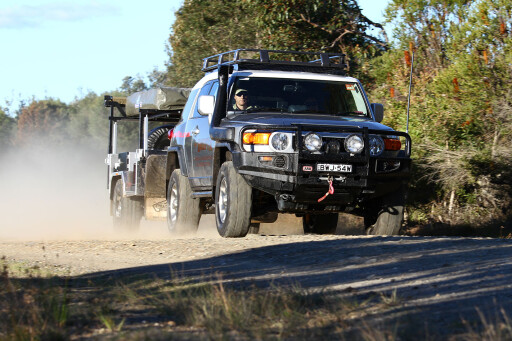 He also doesn’t fancy complicated camping equipment or camp-related tasks. If it’s not practical and quick to set up, then it doesn’t belong in Luke’s kit. Casting your eye over this neat, mildly-customised Toyota FJ Cruiser and custom-made camper-trailer gives an indication of the type of person Luke is. His touring rig ethos is reflected in his own business – Luke is the hands-on owner and brains behind Drifta camp kitchens which, like his vehicle and trailer, are very clever in their design, and are simple and practical to use.
He also doesn’t fancy complicated camping equipment or camp-related tasks. If it’s not practical and quick to set up, then it doesn’t belong in Luke’s kit. Casting your eye over this neat, mildly-customised Toyota FJ Cruiser and custom-made camper-trailer gives an indication of the type of person Luke is. His touring rig ethos is reflected in his own business – Luke is the hands-on owner and brains behind Drifta camp kitchens which, like his vehicle and trailer, are very clever in their design, and are simple and practical to use.
THE PRIME MOVER
Not needing to cart a tribe of kids around, and wanting a little more comfort than his 76 Series Cruiser and dual-cab work trucks afford him, Luke was keen to try out the bush capabilities of the FJ Cruiser as a long-distance tourer for three people; himself, his wife and one rapidly-growing son, plus one of their son’s mates thrown in from time to time.
In Luke’s words, the FJ “is the coolest-looking truck on the market”. Plus, being based on capable Prado running gear and suspension means it provides a damn good start in the long-range touring stakes. Add to that the aftermarket gear he has chosen and we can’t see any reason why it couldn’t be taken anywhere in this wide brown (and sometimes flooded) land.
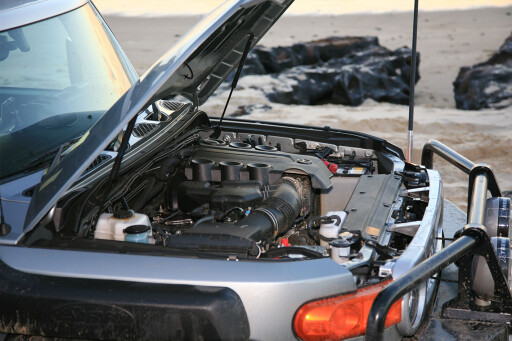 Since there’s no other choice than the 4.0-litre petrol engine in the FJ, Luke saw fit to protect it as best he could with a Safari snorkel fitment. He figured the factory rear diff lock was good to go as is. To boost clearance the FJ has been given a 50mm lift with a set of ARB’s Old Man Emu dampers and coil springs.
Since there’s no other choice than the 4.0-litre petrol engine in the FJ, Luke saw fit to protect it as best he could with a Safari snorkel fitment. He figured the factory rear diff lock was good to go as is. To boost clearance the FJ has been given a 50mm lift with a set of ARB’s Old Man Emu dampers and coil springs.
While the factory alloy rims were retained, Luke flicked the standard rubber in favour of Mickey Thompson Baja 265/70 R17 MTZs, which are a far better bet for bush work. An ARB steel roof-rack is mounted atop the FJ to handle extra loads but can also do double-duty to carry the rooftop tent that usually resides on the trailer.
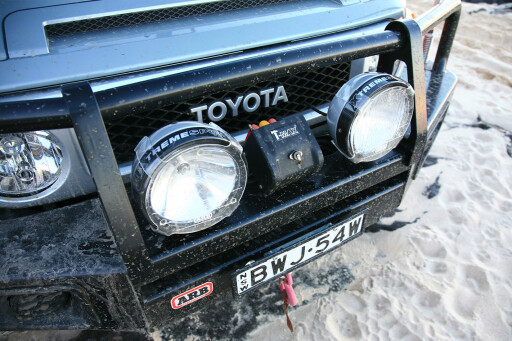 An ARB steel winch bar graces the front of the FJ. It carries a set of IPF Extreme driving lights and a low-mount T-Max 9000lb electric winch with synthetic rope and alloy hawse fairlead instead of a steel cable and roller fairlead. So, now he can see what he’s getting himself into, Luke can also get himself out of it should that rear locker not provide enough oomph.
An ARB steel winch bar graces the front of the FJ. It carries a set of IPF Extreme driving lights and a low-mount T-Max 9000lb electric winch with synthetic rope and alloy hawse fairlead instead of a steel cable and roller fairlead. So, now he can see what he’s getting himself into, Luke can also get himself out of it should that rear locker not provide enough oomph.
A Supercharge Amp-Tech deep-cycle battery has been shoehorned into the engine bay, and is charged via an ARB dual-battery kit. This arrangement also trickles power to the rear-mounted Waeco fridge as well as a third, trailer-mounted deep-cycle battery. This battery runs camp lights, accessories and the rooftop tent.
 In the rear of the FJ is one of Luke’s company’s latest achievements – fitting a drawer and kitchen set-up into the FJ’s smallish cargo area. The Waeco fridge rolls out smoothly on the fridge slide, while underneath is a pair of slide-out drawers. What’s not so apparent is the camping table that is cleverly enveloped between the top deck of the drawer system and the lower right-hand-side drawer. It allows easy access to an often-needed work surface on which to prepare roadside meals.
In the rear of the FJ is one of Luke’s company’s latest achievements – fitting a drawer and kitchen set-up into the FJ’s smallish cargo area. The Waeco fridge rolls out smoothly on the fridge slide, while underneath is a pair of slide-out drawers. What’s not so apparent is the camping table that is cleverly enveloped between the top deck of the drawer system and the lower right-hand-side drawer. It allows easy access to an often-needed work surface on which to prepare roadside meals.
 Inside, the FJ is largely stock except for the dash-mounted Garmin Nüvi navigator (mounted next to the factory ‘fall-over’ meters) and GME TX 3540 UHF radio affixed to the centre console.
Inside, the FJ is largely stock except for the dash-mounted Garmin Nüvi navigator (mounted next to the factory ‘fall-over’ meters) and GME TX 3540 UHF radio affixed to the centre console.
THE TRAILER
Now, this is where Luke has attempted to address the weight issue and lengthy set-up times of many camper-trailers on the market. In collaboration with Trackabout Off-road Camper Trailers, Luke designed his 6x4-foot trailer based on Trackabout’s Deluxe Tourer design but without the normal canvas camping top. Instead, he opted for a high-mounted Hannibal rooftop tent which rests on a framework that raises it 400mm from its standard travelling position.
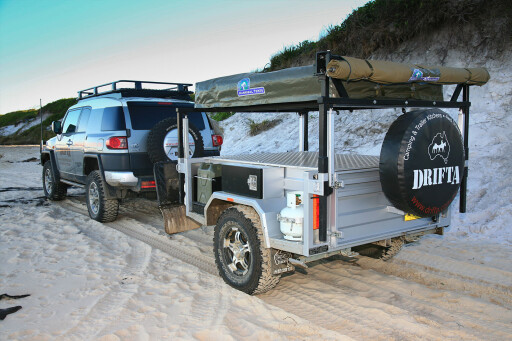 Why? Well, Luke wanted to maintain space under the tent bed-base to carry canoes, push bikes and other toys, while being able to easily reach the tent to set it up without the need for ladders or clambering up the sides of the trailer. This also keeps the centre of gravity reasonably low for driving off-road. Once set up, however, the whole thing lifts via four 12-volt linear actuators which source their power from the trailer’s toolbox-mounted 100-amp-hour deep-cycle battery.
Why? Well, Luke wanted to maintain space under the tent bed-base to carry canoes, push bikes and other toys, while being able to easily reach the tent to set it up without the need for ladders or clambering up the sides of the trailer. This also keeps the centre of gravity reasonably low for driving off-road. Once set up, however, the whole thing lifts via four 12-volt linear actuators which source their power from the trailer’s toolbox-mounted 100-amp-hour deep-cycle battery.
While no-one is watching, Luke can flick a switch and stare in amazement with everyone else as the tent mysteriously rises above head height. It’s this extra height that then allows the tent’s awning and the rear-mounted Hannibal (legless) awning to achieve head-clearance – even for the tall and lanky. In case you’re wondering what these lifters are rated at, each one is able to lift 50kg and hold up to 250kg.
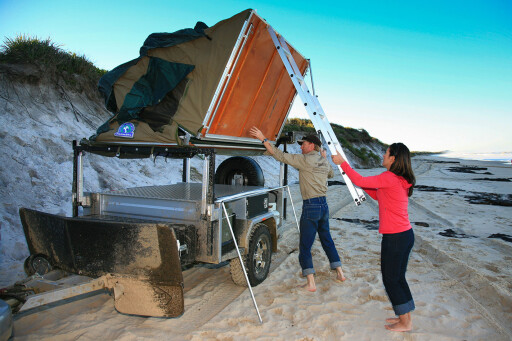 An OzHitch off-road hitch is used to mate the trailer to the FJ, while electric drum brakes help slow the show. All corners of the trailer are jam-packed with LPG bottles, jerry cans, 12-volt water pumps, and tool and camping-related boxes. Cleverly, the front drawbar-mounted box has two weatherproof power outlets, one of which has been modified to allow the power lead to hook up to the tent’s lifting actuators – simple, dust- and waterproof, and cheap.
An OzHitch off-road hitch is used to mate the trailer to the FJ, while electric drum brakes help slow the show. All corners of the trailer are jam-packed with LPG bottles, jerry cans, 12-volt water pumps, and tool and camping-related boxes. Cleverly, the front drawbar-mounted box has two weatherproof power outlets, one of which has been modified to allow the power lead to hook up to the tent’s lifting actuators – simple, dust- and waterproof, and cheap.
The trailer runs on reliable leaf springs with seven leaves, no dampers, just a rebound leaf to help control the bounce.
As you would expect from the fella that owns Drifta, there is one of his slide-out camp kitchens with a sliding drawer to fully utilise the trailer’s internal space. Some of you may think we’re a little bonkers after drooling over the photos and knowing full well that Drifta only manufactures timber kitchen units. You may be tempted to email us right now saying “They look like stainless-steel, you twits” but, hold your horses, these units are a set of Luke’s latest timber units complete with a stainless-look veneer finish. They maintain all the easy-to-work-with attributes of timber but with the classy look of stainless – a win-win situation.
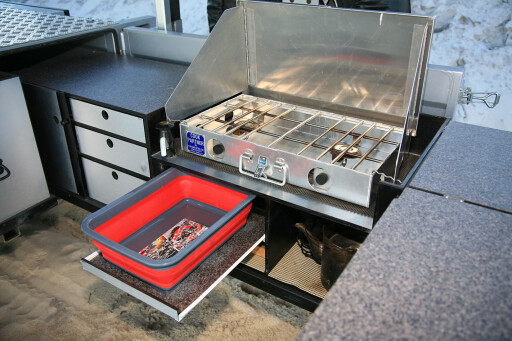 Collapsible buckets/tubs serve as a kitchen sink and hand basin, a manually-operated hand pump draws water from the underslung tank (or a jerry placed under the sink) and a US-sourced two-burner cooker knocks up most of the culinary delights while out on the road.
Collapsible buckets/tubs serve as a kitchen sink and hand basin, a manually-operated hand pump draws water from the underslung tank (or a jerry placed under the sink) and a US-sourced two-burner cooker knocks up most of the culinary delights while out on the road.
A front-mounted mesh stone deflector and underslung mudflaps reduce stone strikes to the trailer’s silver-painted finish. We do say reduce, not prevent, as no matter how much you try to block those damn gibbers from damaging your pride and joy some will always find a way through the barriers.
As you might have noticed there isn’t a lot of undercover area protected from the elements, however, Luke does have extra sidewalls that clip on to the rear Hannibal awning to provide a little more protection. It’s probably still no match for the all-encompassing canvas units that some folk haul around, but that’s part of the appeal for Luke and his wife – quick, easy and lightweight.
If there is need for extra sleeping space should their son’s mate come along for the ride, then a ground-based Oztent handles the duties of cubby house for the kids.
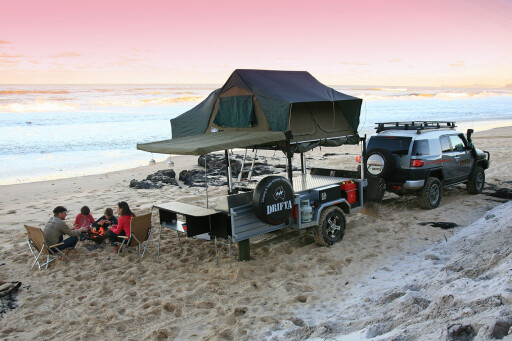 All up, his camper offers a small footprint, can be set up almost anywhere – even on muddy or wet ground – and signs off on all Luke’s wants. In his mind, it’s the perfect touring set-up and if you happen to think so too, he’s now manufacturing them for the public.
All up, his camper offers a small footprint, can be set up almost anywhere – even on muddy or wet ground – and signs off on all Luke’s wants. In his mind, it’s the perfect touring set-up and if you happen to think so too, he’s now manufacturing them for the public.
We can see it now: a whole new breed of inspired campers calling themselves nomads, roaming the backblocks of Australia. Here one minute, gone the next, not a care in the world. Doesn’t sound like such a bad idea.

COMMENTS